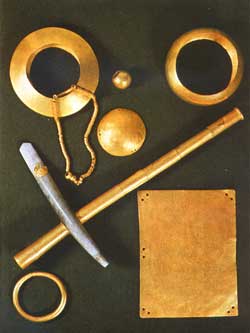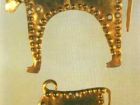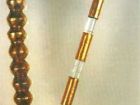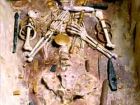THE GOLD OF VARNA PREHISTORIC NECROPOLIS - THE BEGINNING OF SOCIAL DIVISION OF SOCIETY
THE GOLD OF VARNA PREHISTORIC NECROPOLIS
THE BEGINNING OF SOCIAL DIVISION OF SOCIETY
THE BEGINNING OF SOCIAL DIVISION OF SOCIETY
There is no doubt we are not dealing with a treasure of a trivial kind. Its nature is outstanding. A happy coincidence in 1972 provided science with invaluable data. Digging a trench for an electric cable in the western industrial part of the city of Varna the man working with the excavator discovered in the soil discarded by the machine several gold objects, pieces of ceramics and other items. Hearing about this, archeologists from the Varna Archeological Museum started excavations on the spot. This gave world culture a unique monument of the culture of the oldest inhabitants of Europe.
They discovered a graveyard (in scientific terminology - necropolis 'city of the dead'), belonging to some unknown prehistoric settlement.
Since it was situated very close to the Varna Lake (500 m) it must have been connected to some of the lake settlements, built in the water on stakes stuck in the bottom. This presupposition was supported by various finds in the mud of the lake - ceramics, instruments of stone and flint, etc.
Excavations went on for many years and tens on 3200-3000 BC. The results surpassed the boldest expectations of archeologists.
Obviously there were three different ways of burying the dead — lying on their back with the body stretched and with a huddled body, with arms and legs curved. The third type was the so-called "Symbolic burial" where no skeletons were found in the graves but the burial objects were present. Very interesting are the bodies buried in huddled position, known in scientific literature as hokers. It is believed that they imitated the position of the embrio in the womb. In this way the prehistoric people expressed the idea that a man must leave this world in the way he came into it.

All graves of these two types contain rich burial inventory of objects - things that had to serve the dead person in the other world. These were vessels of clay with rich decoration of cut lines, often painted with white paste, as well as the vessels decorated with graphite, so characteristic of the Eneolithic period.
They also contained instruments of copper, stone, flint and bone (knives, axes, and cutting blades), jewelry made of metal, sea-shells (in one of the graves they are about 2200), a rare kind of quartz and china clay.
There are also a large number of idols made of flat bones in the form of stylized human figures. Each of the graves contains between 2 and 5 vessels, while the instruments are placed in the hands of the dead person.
The third type of burial, the symbolic one, is extremely rare in the Eneolythic period (known with the term cenotaph). The lack of a dead body is explained with some peculiarities of the cult concepts and most of all with the fact that the burial ritual was performed for a member of the community who had fallen dead far away, in battle or in hunting.
Observing the unwritten laws, these "empty" graves also contained burial objects. As a matter of fact they are richest in gold objects while in the "real" graves they are considerably less in number. The quantity of the gold is impressive. Thus in grave 4 (in the order of their discovery) there were 1518 gold objects, and in grave 1 their overall weight exceeds 1 kg.
Excavations established that the gold finds were placed exactly where they belonged: the bracelets of thick wire - on the wrists and above the elbows; the earrings, made of thin gold wire - on both sides of the head; the cylindrical gold beads - on the chest, between the ribs, as well as the gold figures of people and animals which obviously had a ritual function. It is interesting that in some of the symbolic graves there were human faces made of clay surrounded by rich decorations of round and rectangular gold plates.
The forehead was decorated with a gold diadem.
Where the arms were supposed to be stood beautiful ritual axes of stone with gold handles.
This must have been a way to indicate the high social position of the person buried.
All this is to show that the community during the Eneolythic period had undergone social stratification, which inevitably leads to a class society.
The nature and special features of the Varna necropolis and especially the fine work of the gold objects employing hammering, piercing and cutting, suggest high level of technology, well-developed social and cultural processes and spiritual culture. This explains the great interest of specialists all over the world in this find. The products of art of this monument have been exposed in the most prestigious museums of the world.







